KEF V-20W User Manual [en, de, es, fr]
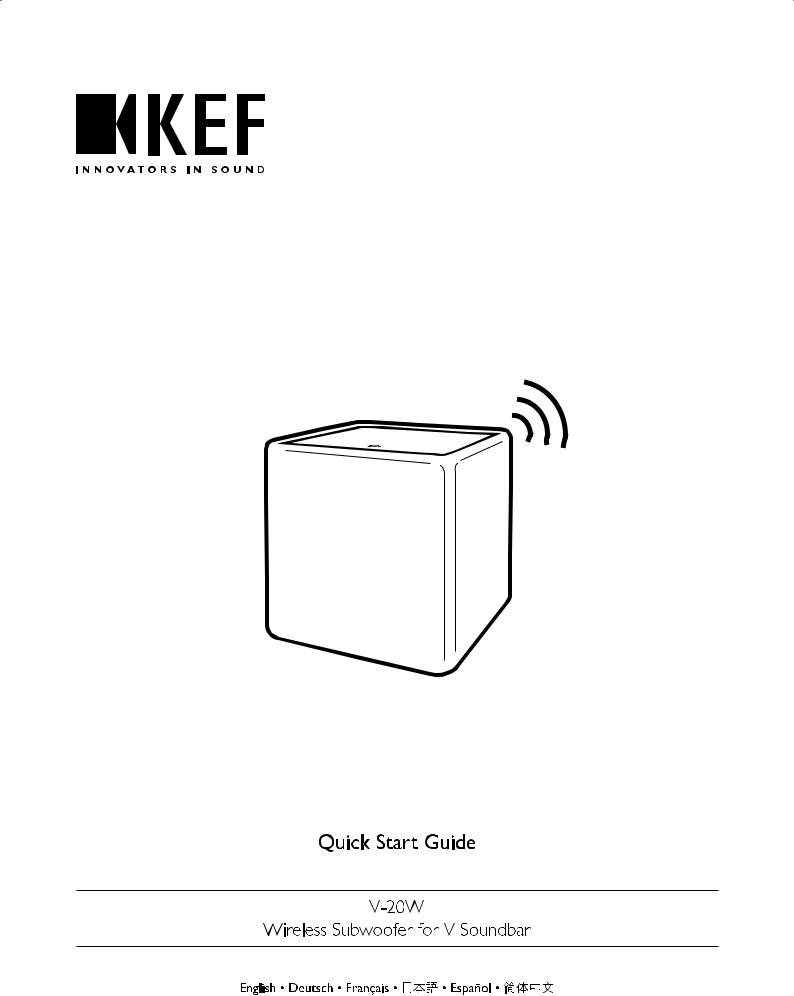
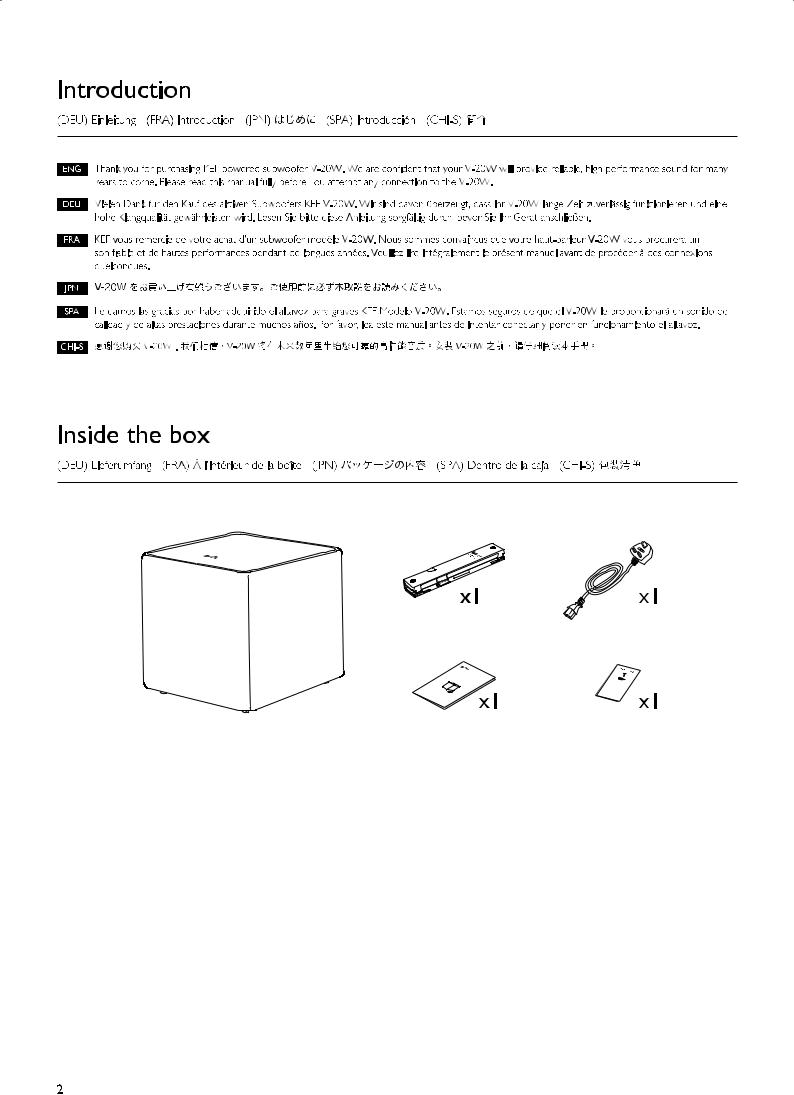
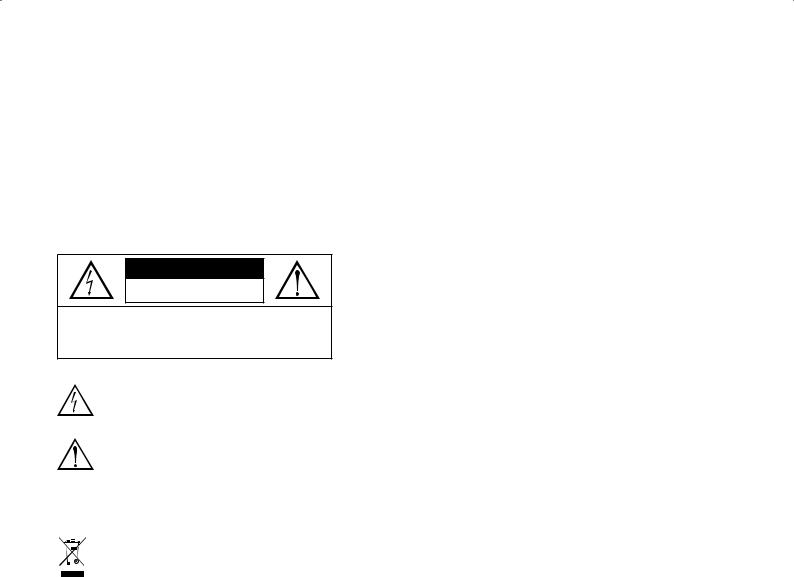
Important safety instructions |
|
||
ENG |
|||
|
|
||
• Follow this manual carefully for best results from your speakers |
• Avoid damp |
|
|
• Read and return warranty card |
• Avoid temperature extremes |
|
|
• Clean with a dry lint free cloth |
• Avoid direct sunlight |
|
|
• Do not use spirit based cleaners |
• SAFETY NOTICE! trailing cables are dangerous, secure all cables |
|
|
|
|
|
|
|
WARNING |
|
|
TO REDUCE THE RISK OF FIRE OR ELECTRICAL SHOCK, DO NOT EXPOSE THIS APPLIANCE TO RAIN OR MOISTURE |
|
||
|
|
|
|
CAUTION |
RISK OF ELECTRIC SHOCK |
DO NOT OPEN |
CAUTION: TO REDUCE THE RISK OF ELECTRIC SHOCK, DO |
NOT REMOVE COVER (OR BACK). |
NO USER-SERVICEABLE PARTS INSIDE. REFER SERVICING TO |
QUALIFIED SERVICE PERSONNEL. |
Explanation of Graphical Symbols
The lightning flash with arrowhead symbol, within an equilateral triangle, is intended to alert the user to the presence of uninsulated “dangerous voltage” within the products enclosure that may be of a sufficient magnitude to constitute a risk of electrical shock to persons.
The exclamation mark within an equilateral triangle is intended to alert the user to the presence of important operating and maintenance (servicing) instructions in the literature accompanying the appliance.
•A combined mains power input lead and country specific mains plug is provided.
•Check before connecting to your local mains supply that the local supply voltage is the same as that marked on the rear panel. If it is not, check with your supplier before proceeding.
Caution: Any changes or modifications not expressly approved by the party responsible for compliance could void the user’s authority to operate this equipment.
This equipment complies with FCC radiation exposure limits set forth for an uncontrolled environment.
This equipment should be installed and operated with minimum distance 20cm between the radiator & your body and must not be co-located in conjunction with any other antenna or transmitter.
This device complies with part 15 of the FCC Rules. Operation is subject to the following two conditions: (1) This device may not cause harmful interference, and
(2) This device must accept any interference received, including interference that may cause undesired operation.
WARNING:
Due to the mains switch being located on the rear panel, the appliance must be located in an open area without anything obstructing access to the mains switch. The apparatus should be connected to a mains socket with a protective earthing connection.
Correct Disposal of this product. This marking indicates that this product should not be disposed with other household wastes throughout the EU. To prevent possible harm to the environment or human health from uncontrolled waste disposal, recycle it responsibly to promote the sustainable reuse of material resources. To return your used device, please use the return and collection systems or contact the retailer where the product was purchased. They can take this product for environmentally safe recycling.
Please take heed of the following before using the KEF ModelV-20W. Note also that the word“appliance” shall refer to the KEFV-20W subwoofer,or any part of it.
1.Read Instructions – All the Safety and Operating Instructions should be read before the appliance is operated.
2.Retain Instructions – The Safety and Operating Instructions should be retained for future reference.
3.HeedWarnings – All warnings on the appliance and in the Operating Instructions should be adhered to.
4.Follow Instructions – All Operating and Use Instructions should be followed. Only use attachments/accessories specified by the manufacturer.
5.Important – Do not defeat the safety purpose of the polarized or grounding type plug. The third prong is provided for your safety. If the provided plug does not fit into your outlet, consult an electrician for replacement of the obsolete outlet. Refer all servicing to a qualified service personnel. Servicing is required for any damaged parts such as power-supply cordor plug.
6.Water and Moisture – The appliance should not be used in or near water - for example, near a bathtub, washbowl, kitchen sink, laundry tub, in a wet basement, or near a swimming pool, and the like. The appliance shall not be exposed to dripping or splashing. Care should be taken so that objects containing liquids are not placed upon or spilled into the enclosure through openings and that no objects filled with liquids, such as a vase, shall be placed on the appliance.
7.Ventilation – The appliance should be situated so that its location or position does not interfere with its proper ventilation. For example, the appliance should not be situated on a bed, sofa, or similar surface that may block any ventilation openings.
8.Heat – The appliance should be situated away from heat sources such as radiators, heat registers, stoves or other appliances (including amplifiers) that produce heat.
9.Power Sources – The appliance should be connected to a power supply only of the type described in the Operating Instructions or as marked on the appliance and it shall remain readily operable. Mains plug is used as the disconnect device. To be completely disconnected from the power input, the mains plug of the appliance must be disconnected from the mains completely.
10.Power-cord Protection – Power supply cords should be routed so that they are not likely to be walked on or pinched by items placed upon or against them, paying particular attention to cords at plugs, convenience receptacles and the point where they exit from the appliance. The main plug should not be obstructed OR should be easily accessed during intended use.
11.Attachments andAccessories – Use only attachments/accessories specified by the manufacturer.
12.Handling – The appliance should be transported with the cart, stand, tripod, bracket, or table specified by manufacturer, or sold with the apparatus. When a cart is used, use caution when moving the cart/appliance combination to avoid injury from tip-over.
13.Non-use Periods – Unplug this appliance during lightning storms or when unused for long periods of time.
14.Damage Requiring Service – The appliance should be serviced by qualified service personnel when:
a)The power supply cord or the plug has been damaged; or
b)Objects have fallen or liquid has been spilled into the appliance; or
c)The appliance has been exposed to rain; or
d)The appliance does not appear to operate normally or exhibits a marked change in performance; or
e)The appliance has been dropped or the enclosure damaged.
15.Servicing – The user shall not attempt to service the appliance beyond that described in the Operating Instructions. All other servicing should be referred to qualified service personnel.
3
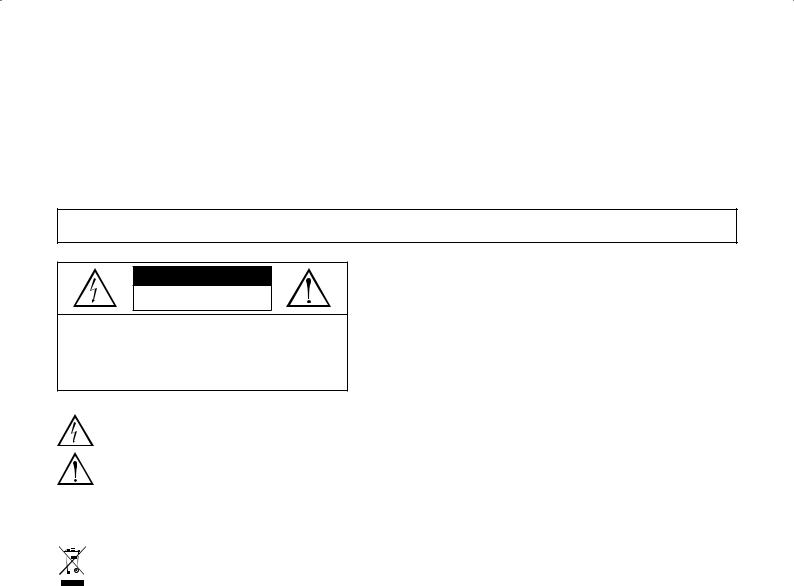
Sicherheitshinweise |
|
|
|
|
|
DEU |
|
|
|
|
|
• Befolgen Sie dieses Handbuch genau, um die besten Ergebnisse für Ihre |
• Vermeiden Sie feuchte Umgebungen |
||
Lautsprecher zu bekommen |
• |
Vermeiden Sie Extremtemperaturen |
|
• Lesen Sie sich die Garantiekarte durch, und schicken Sie sie zurück |
• Vermeiden Sie direkte Sonneneinstrahlung |
||
• Reinigen Sie das Gerät mit einem trockenen, flusenfreien Tuch |
• |
SICHERHEITSHINWEIS! Lockere Kabelschlaufen sind gefährlich, sichern Sie alle |
|
• Verwenden Sie keine Reinigungsmittel auf Alkoholbasis |
|
Kabel ab |
|
WARNHINWEIS
BITTE SETZEN SIE DAS GERÄT WEDER REGEN NOCH FEUCHTIGKEIT AUS, UM DAS RISIKO EINES BRANDS ODER EINES STROMSCHLAGS ZU VERRINGERN.
ACHTUNG |
STROMSCHLAGRISIKO |
NICHT ÖFFNEN |
ACHTUNG: NEHMEN SIE DEN GEHÄUSEDECKEL (ODER |
DIE GEHÄUSERÜCKSEITE) NICHT AB, ES BESTEHT DIE |
GEFAHR EINES STROMSCHLAGS. ES BEFINDEN SICH KEINE |
VOM BENUTZER ZU REPARIERENDE/WARTENDE TEILE |
INNERHALB DES GERÄTS. BITTE WENDEN SIE SICH IM |
SERVICEFALL AN QUALIFIZIERTES FACHPERSONAL. |
Symbolerklärung |
•Ein Netzkabel mit länderspezifischem Stecker ist im Lieferumfang inbegriffen.
•Prüfen Sie, ob die örtliche Stromspannung der Beschriftung auf der Rückseite entspricht, bevor
Sie das Gerät an eine Steckdose anschließen. Wenn dies nicht der Fall ist, wenden Sie sich an Ihren Lieferanten, bevor Sie fortfahren.
Das Symbol eines Blitzes mit einer Pfeilspitze innerhalb eines gleichseitigen Dreiecks zeigt dem Benutzer das Vorhandensein einer nicht abgeschirmten Spannung im Gehäuse an, die so hoch sein kann, dass Personen einen elektrischen Schock erleiden können.
Das Ausrufezeichen innerhalb eines gleichseitigen Dreiecks weist den Benutzer auf wichtige Bedienungsund Wartungshinweise in der mitgelieferten Gerätedokumentation hin.
WARNHINWEIS:
Da sich der Netzschalter auf der Rückseite befindet, muss das Gerät an einem Ort aufgestellt werden, der einen freien Zugang zum Netzschalter gewährt. Das Gerät sollte an eine Steckdose mit geerdetem Schutzleiter angeschlossen werden.
Korrekte Entsorgung dieses Produkts. Diese Markierung gibt an, dass dieses Produkt innerhalb der EU nicht mit dem normalen Haushaltsmüll entsorgt werden darf.
Um mögliche Umweltund Gesundheitsschäden aus unkontrollierter Abfallentsorgung zu vermeiden, recyceln Sie es verantwortungsbewusst, um die nachhaltige Wiederverwendung von Rohstoffen zu fördern.
Verwenden Sie zur Rückgabe Ihres Altgeräts bitte die entsprechenden Rücknahmeund Sammelsysteme, oder wenden Sie sich an den Händler, bei dem das
Produkt gekauft wurde. Diese können das Produkt einem umweltverträglichen Recycling zuführen.
Beachten Sie vor Verwendung des KEF V-20W bitte Folgendes. Beachten Sie bitte, dass sich der Begriff „Gerät“ auf den KEF V-20W bzw. einen Teil des KEF V-20W bezieht.
1. Lesen Sie dieAnleitung – Lesen Sie alle Sicherheitshinweise und die Bedienungsanleitung, bevor Sie das Gerät in Betrieb nehmen.
2.Bewahren Sie dieAnleitung auf – Die Bedienungsanleitung sollte zur zukünftigen Verwendung aufbewahrt werden.
3.Beachten SieWarnungen – Alle Warnungen auf dem Gerät und in der Bedienungsanleitung sollten beachtet werden.
4.Befolgen SieAnweisungen – Alle Bedienungsund Verwendungshinweise müssen befolgt werden. Verwenden Sie nur vom Hersteller angegebene Befestigungen/Zubehörteile.
5.Wichtig - Umgehen Sie nicht den Sicherheitszweck des polarisierten bzw. geerdeten Steckers. Der dritte Stift ist für Ihre Sicherheit gedacht. Wenn der Stecker des Geräts nicht in Ihre Steckdose passt, ziehen Sie einen Elektriker zu Rate, um die veraltete Steckdose zu ersetzen. Wenden Sie sich im Servicefall bitte stets an qualifiziertes Fachpersonal. Wartungsarbeiten oder Reparaturen sind erforderlich, wenn Teile wie das Netzkabel oder der Stecker beschädigt sind.
6.Wasser und Feuchtigkeit - Verwenden Sie das Gerät nicht in der Nähe von Wasser, z. B. in der Nähe einer Badewanne, eines Waschbeckens, einer Küchenspüle oder einer Wäschewanne, in einem feuchten Keller oder in der Nähe eines Schwimmbads, etc. Das Gerät muss vor Tropfen und Spritzwasser geschützt werden. Achten Sie darauf, keine Gegenstände mit Flüssigkeiten auf das Gehäuse zu stellen, und verhindern Sie, dass Flüssigkeiten durch Öffnungen in das Gehäuse gelangen. Mit Flüssigkeiten gefüllte Gegenstände wie z.B. Vasen dürfen nicht auf das Gerät gestellt werden.
7.Belüftung – Das Gerät muss so aufgestellt werden, dass die Belüftung des Geräts nicht beeinträchtigt wird. Das Gerät sollte beispielsweise nicht auf einem Bett oder Sofa oder auf einer ähnlichen Oberfläche positioniert werden, welche eventuell die Ventilationsöffnungen blockieren könnte.
8.Wärme – Stellen Sie das Gerät nicht in der Nähe von Wärmequellen, z. B. Heizkörper, Heizstrahler, Öfen oder anderen wärmeerzeugende Geräte (auch Verstärker), auf.
9.Stromquellen – Das Gerät sollte nur an Stromquellen angeschlossen werden, die in der Bedienungsanleitung beschrieben oder am Gerät vermerkt sind, und jederzeit betriebsbereit bleiben. Der Netzstecker wird als Trenngerät verwendet. Für eine vollständige Trennung der Verbindung zur Stromquelle muss der Netzstecker des Geräts vollständig aus der Steckdose gezogen werden.
10.Schutz des Netzkabels – Netzkabel sollten so geführt werden, dass nicht darauf getreten wird oder sie durch Gegenstände, die darauf oder dagegen gestellt oder gelegt werden, eingeklemmt werden. Achten Sie besonders auf die Kabelabschnitte an Steckern, Verlängerungsleitungen und an dem Punkt, an dem sie aus dem Gerät kommen. Der Netzstecker darf nicht versperrt sein, ODER muss bei der beabsichtigten Verwendung leicht zugänglich sein.
11.Befestigungen und Zubehörteile – Verwenden Sie nur vom Hersteller angegebene Befestigungen/Zubehörteile.
12.Handhabung – Verwenden Sie das Gerät nur mit dem vom Hersteller angegebenen oder mit dem Gerät gelieferten Wagen, Ständer, Stativ, Tisch oder entsprechender Halterung.
Wenn ein Wagen verwendet wird, seien Sie vorsichtig, wenn Sie den Wagen mit dem Gerät bewegen, um Verletzungen durch ein mögliches Umfallen zu vermeiden.
13.Nichtbenutzung – Ziehen Sie bei Gewittern oder im Fall, dass das Gerät für längere Zeit nicht verwendet werden soll, den Stecker aus der Steckdose.
14.Beschädigungen,die eine Reparatur erforderlich machen – In folgenden Fällen sollte das Gerät von qualifiziertem Servicepersonal repariert werden:
a)Das Netzkabel oder der Stecker sind beschädigt; oder
b)Gegenstände oder Flüssigkeiten sind in das Gehäuse gelangt; oder
c)Das Gerät war Regen ausgesetzt; oder
d)Das Gerät scheint nicht richtig zu funktionieren oder zeigt deutliche Leistungsveränderungen; oder
e)Das Gerät wurde fallen gelassen, oder das Gehäuse wurde beschädigt.
15.Wartung – Der Anwender darf keine Wartung am Gerät durchführen, die nicht ausdrücklich im Handbuch beschrieben ist. Alle anderen Wartungsfälle sollten qualifiziertem Fachpersonal überlassen werden.
4
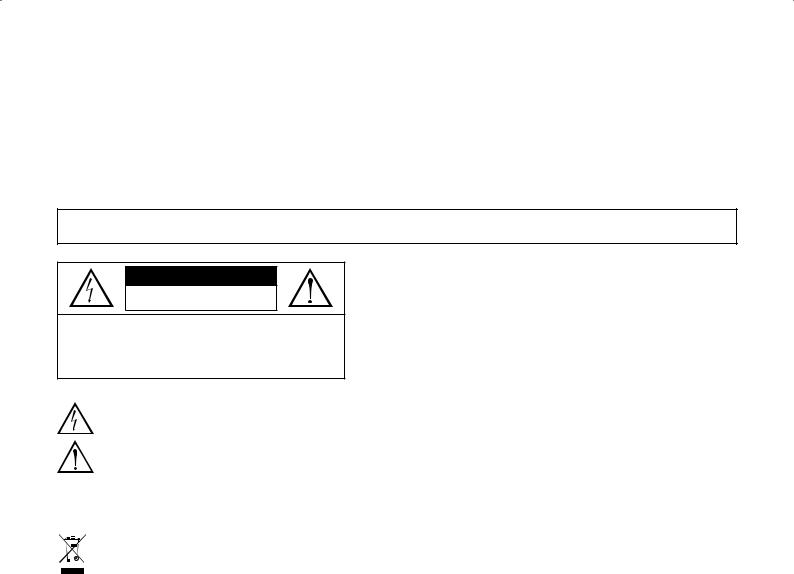
Précautions d'emploi |
|
|
|
FRA |
|
|
|
|
• Suivez attentivement les instructions de ce manuel pour tirer le meilleur parti de |
• Évitez les environnements humides |
|
vos haut-parleurs |
• Évitez les températures extrêmes |
|
• Lisez et renvoyez la carte de garantie |
• Éviter la lumière solaire directe |
|
• Nettoyez avec un chiffon sec non pelucheux |
• INFORMATION SÉCURITÉ ! Des câbles traînant sur le sol peuvent être |
|
• N'utilisez pas de produits nettoyants à base d'alcool |
dangereux, rangez tous les câbles |
|
AVERTISSEMENT
POUR RÉDUIRE LES RISQUES D’INCENDIE OU DE CHOC ÉLECTRIQUE, N’EXPOSEZ PAS CE MATÉRIEL À L’EAU OU À L’HUMIDITÉ.
ATTENTION |
RISQUE DE CHOC ÉLECTRIQUE |
NE PAS OUVRIR |
ATTENTION : POUR RÉDUIRE LES RISQUES DE CHOC |
ÉLECTRIQUE, N’ENLEVEZ PAS LE COUVERCLE OU LE |
CAPOT ARRIÈRE. AUCUNE PIÈCE INTERNE NE PEUT ÊTRE |
RÉPARÉE PAR L’UTILISATEUR. LA MAINTENANCE DOIT ÊTRE |
EFFECTUÉE PAR DES TECHNICIENS QUALIFIÉS. |
•Une alimentation d’entrée et une fiche spécifique aux normes électriques de votre pays sont fournies.
•Avant de raccorder l’appareil à votre réseau électrique, vérifiez que la tension du réseau correspond à la tension indiquée sur la plaque signalétique. Si ce n’est pas le cas, contactez votre revendeur avant toute opération.
Explication des symboles
L‘éclair fléché dans un triangle équilatéral avertit l’utilisateur de la présence d’une “tension dangereuse” non isolée à l’intérieur de l’appareil, d’une valeur suffisante pour constituer un risque d’électrocution aux personnes.
Le symbole représentant un point d’exclamation à l’intérieur d’un triangle équilatéral signale à l’utilisateur la présence d’instructions importantes relatives au fonctionnement et à l’entretien de l’appareil (maintenance) dans le manuel accompagnant ce produit.
AVERTISSEMENT:
L’interrupteur principal étant situé sur le panneau l’arrière, cet appareil doit être utilisé dans une zone ouverte, sans que rien n’empêche l’accès à l’interrupteur principal. L’appareil doit être connecté au réseau électrique via une prise équipée d’une connexion de protection vers la terre.
Élimination correcte de ce produit. Le symbole indique que ce produit ne peut pas être traité comme un déchet ménager en Union Européenne. Par mesure de prévention pour l’environnement et pour la santé humaine et pour éviter l’élimination incontrôlée des déchets, veuillez le recycler conformément au principe de réutilisation des ressources matérielles.
Pour renvoyer votre appareil usagé, utilisez les systèmes de renvoi et de collecte qui vous sont proposés ou contactez le revendeur chez qui vous avez acheté ce produit. Ils peuvent faire recycler ce produit en respectant l’environnement.
Respectez les recommandations suivantes avant d’utiliser le KEF V-20W. Veuillez noter que le mot « appareil » renvoie au KEF V-20W ou à n’importe quelle partie de celui-ci.
1.Lisez le manuel d’instructions — Toutes les instructions de Sécurité et de Fonctionnement doivent être lues avant d’utiliser l’appareil.
2.Conservez le manuel d’instructions — Toutes les instructions de Sécurité et de Fonctionnement doivent être conservées pour un usage futur.
3.Respectez les Avertissements — Tous les avertissements figurants sur le produit ou dans le manuel d’instructions doivent être respectés.
4.Suivez les instructions — Toutes les instructions de fonctionnement et d’usage doivent être respectées. Utilisez uniquement des accessoires et des pièces spécifiés par le fabricant.
5.Important — Ne tentez pas de modifier les dispositifs de sécurité que constituent les fiches de type terre ou polarisées. La troisième fiche est présente à des fins de sécurité. Si la fiche fournie ne rentre pas dans votre prise, appelez un électricien pour remplacer la prise obsolète. Toute maintenance doit être effectuée par des techniciens qualifiés. Une opération de maintenance est requise pour intervenir sur une prise, une fiche ou un câble endommagés.
6.Eau et humidité — Cet appareil ne doit pas être utilisé dans ou près de l’eau - par exemple près d’une baignoire, d’un évier de cuisine, d’un lavabo, dans un sous-sol humide, près d’une piscine et autres endroits similaires. L’appareil ne doit pas être exposé à des éclaboussures où à des ruissèlements. Vous devez veiller à ce qu’aucun objet contenant des liquides ne soit posé à proximité de l’appareil ou renversé à proximité des ouvertures. Vous devez veiller à ce qu’aucun objet contenant des liquides, comme par exemple, mais pas seulement, un vase, ne soit placé sur l’appareil.
7.Ventilation — L’appareil doit être placé dans une position ou dans un lieu qui n’interfère pas avec le bon fonctionnement de sa ventilation. Par exemple, l’appareil ne doit pas être placé sur un lit, un canapé, un sofa ou toute surface similaire pouvant potentiellement obstruer les ouvertures de ventilation.
8.Chaleur — L’appareil doit être éloigné de sources de chaleur comme les radiateurs, les chaudières, les bouches d’aération de chauffage central ou d’autres appareils (y compris des amplificateurs) produisant de la chaleur.
9.Alimentation électrique — L’appareil doit être relié à une source d’alimentation électrique uniquement conforme à la description qui en est faite dans le manuel d’instructions ou comme indiqué sur l’appareil. Elle doit rester facilement accessible en toutes circonstances. La fiche principale est utilisée comme dispositif de déconnexion. Pour déconnecter complètement l’alimentation électrique, la fiche du câble alimentation de l’appareil doit être complètement retirée de la prise du réseau électrique.
10.Protection du câble d’alimentation — Les câbles d’alimentation électrique doivent être disposés de manière à ce qu’ils ne soient pas écrasés par des objets posés sur, ou contre, eux. Ils doivent être situés hors d’une zone de passage afin que l’on ne marche pas dessus. Soyez particulièrement attentif à la zone d’emplacement des câbles et des fiches, des prises de courant et du point de sortie de l’appareil. La prise principale ne doit pas être obstruée et DOIT être facilement accessible pendant l’usage de l’appareil.
11.Accessoires — Utililsez uniquement des accessoires et des pièces spécifiés par le fabricant.
12.Manipulation — L’appareil doit être transporté avec le chariot, pied, tripode, crochet ou table spécifié par le fabricant, ou vendu avec l’appareil. Si vous utilisez un chariot, portez une attention particulière lorsque vous déplacez l’appareil ou le chariot, afin éviter des blessures dues à un renversement.
13.Périodes d’inactivité — Débranchez l’appareil pendant un orage, ou si vous n’envisagez pas de l’utiliser pendant une longue période.
14.Dommages requérant des réparations — Cet appareil doit être réparée par des techniciens qualifiés quand :
a)Le câble alimentation ou la fiche ont été endommagés, ou que
b)Des objets ou des liquides sont tombés à l’intérieur de l’appareil, ou que
c)L’appareil a été exposé à la pluie ou que,
d)L’appareil semble ne plus fonctionner normalement ou que ses performances sont notablement différentes, ou que
e)L’appareil est tombé ou que le châssis est endommagé.
15.Réparations - L’utilisateur ne doit pas effectuer de maintenance de l’appareil au-delà des opérations décrites dans le manuel d’instructions. Toute autre opération de maintenance doit être effectuée par des techniciens qualifiés.
5

• 書が保証書に替わります。V1
JPN
• うにしてください
|
|
|
|
|
|
|
|
||
|
|
|
||
|
|
|
|
|
|
|
|
||
|
|
|
|
|
|
|
|
|
|
|
|
|
|
|
|
|
|
|
|
: |
|
|||
|
|
|||
( ) |
|
|
||
|
|
|
||
|
|
|
||
6. ールなど。
12.−
14.KEF
15.KEF
6
